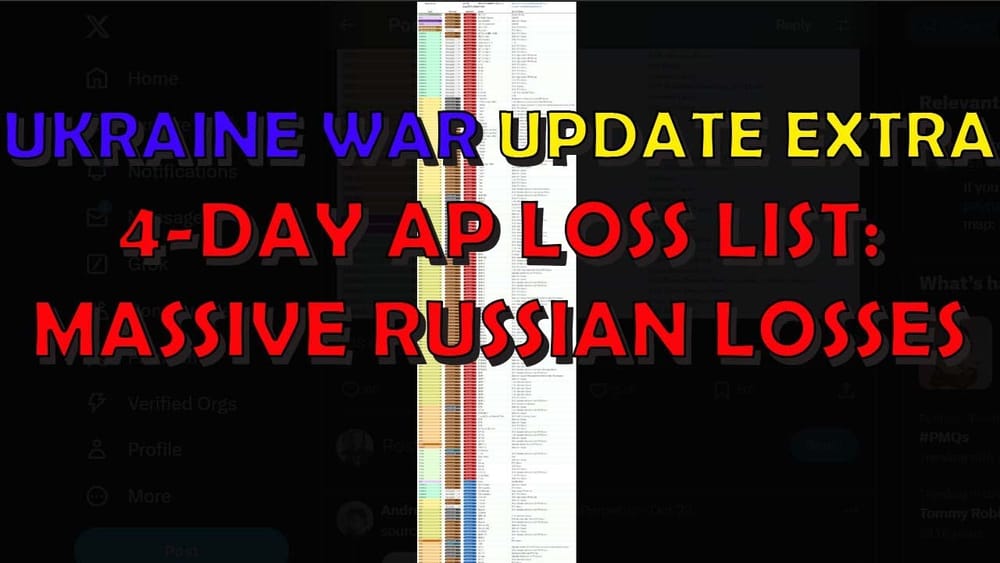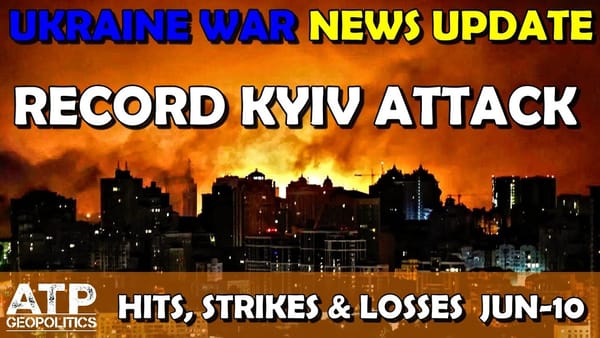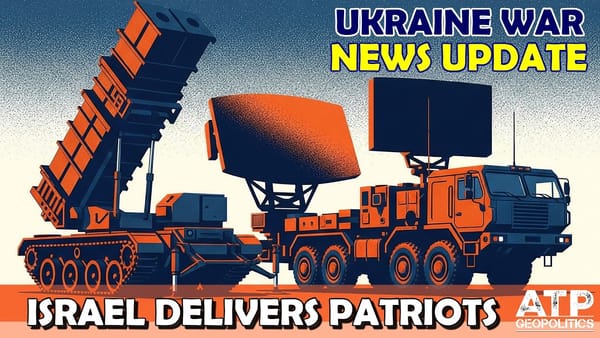Ukraine War Update NEWS: 4-day AP's Equipment Loss Lists
🤖
This summary has been produced automatically by an AI Large Language Model (LLM) without any human intervention. Whilst every effort has been made to prompt the LLM to produce accurate output, there may be inconsistencies, inaccuracies or hallucinations!
Table of Contents 📖
“How long can the Russians keep doing this? How long can they keep taking things from deep storage and throwing them onto the front?”
Hello Team
🎦 00:00-00:30⏩
Jonathan introduces the video as an appendix to his earlier Hits and Losses update. He notes that this update will focus on Andrew Perpetua’s four-day summary of equipment losses.
Return to top⤴️
🪦 DISCLAIMER FOR GENERAL STAFF LOSSES DATA
- These are real people with real lives and real families who love them. Don’t let the numbers sap your humanity.
- These numbers probably aren’t accurate but they’re the best we have and we don’t need them to be accurate to be indicative of patterns of activity.
- All losses are estimates. Losses cannot be counted with accuracy because of the conditions on the ground.
- Both sides would see it to be of their advantage to minimize their own losses maximize the other side’s losses.
- Neither side releases their losses but we have enough transparency from the Ukrainian side to have confidence in they are indicative.
- Personnel losses are hard to count. If a soldier gets injured, heals up, and returns to the front line only to get injured again, is that one loss or two? Also, how to deal with losses from PMC’s or soldiers fighting with RF from occupied territories?
- Equipment losses are hard to count. If an AA complex involves several parts and one part gets disabled, is that a loss, or a fraction of a loss? If a tank gets disabled, repaired, back into the fight, then disabled again, is that one lost tank or two?
- All recorded losses are vulnerable to multiple reporting. We have already seen numerous cases of multiple drones in the air reporting the same loss from different angles as multiple engagements.
- Losses are not always reported on the same day they occurred. It is frequent that drone losses are reported at least 24 hours after other terrestrial equipment losses. Certain losses may not be reported for days or weeks for military intelligence reasons.
Analysis of Andrew Perpetua’s Four-Day Loss List Summary
🎦 00:30-02:46⏩
- Jonathan emphasises the significance of analysing equipment losses to understand the situation on the front lines.
- Perpetua’s summary highlights 452 total losses over four days, with 201 notable losses listed.
- The list excludes certain categories like surveillance, comms, and some civilian equipment.
- Jonathan observes that the list predominantly focuses on combat asset losses, with a roughly 5:1 ratio of Russian to Ukrainian losses. He finds this ratio staggering.
Ukrainian Equipment Losses
🎦 02:46-08:10⏩
- Electronic Warfare: A Ukrainian NOTA electronic warfare system, designed for perimeter protection and drone jamming, was destroyed. Jonathan provides details about the NOTA system based on online information.
- Artillery/Tanks: Minimal losses for Ukraine, with only one damaged AS90/Crab artillery system and three destroyed or damaged T-64 tanks.
- Infantry Fighting Vehicles (IFVs): Losses include a Bradley, two Marders, and a CV9040. Jonathan acknowledges these as significant losses, especially the CV9040.
- Armoured Personnel Carriers (APCs) and Mine-Resistant Ambush Protected Vehicles (MRAPs): Jonathan notes an increase in losses of Western-provided equipment, including five captured vehicles (MaxPro, Cougar, Avata, and a VAB), an M1117, several destroyed VABs, an M113, an FV432, a Striker, a Humvee, and a Senator.
- Analysis: Jonathan points out that while the loss of Western equipment is notable, the overall number of vehicles lost over four days is not bad for Ukraine. He highlights the concern that 100% of the Ukrainian APCs and MRAPs lost were either destroyed, abandoned, or captured.
Russian Equipment Losses
🎦 08:10-14:46⏩
- Key Point: All listed Russian vehicle losses were either destroyed, abandoned, or captured, similar to the Ukrainian trend.
- Air Defence: Significant losses for Russia, including a Buk-M3, an R-934B Sinitsa electronic warfare system, a Kamaz command and control vehicle, and a Yastreb radar system. Jonathan highlights the Yastreb as a $200 million loss.
- Artillery: Considerable losses, including older systems like M46 howitzers, suggesting Russia is digging into its reserves. A BM-21 Grad and an MTLB with an RBU-6000 were also destroyed. Jonathan notes the use of RBU-6000, originally anti-submarine rocket launchers, as indicative of equipment shortages.
- Tanks: Substantial losses, with a mix of T-90M (Russia’s most modern tank), T-80s, T-72s, and T-62s.
- IFVs: Heavy losses, with over 60 IFVs destroyed, abandoned, or captured. This includes BMP-2s, BMP-3s, and BTRs.
- APCs and Trucks: Around 11 APCs were lost, and a smaller number of trucks than usual were reported.
- Analysis: Jonathan emphasises the effectiveness of Ukrainian tactics, particularly the use of mines and drones, in inflicting these losses.
Overall Assessment of Losses and Implications for Russia
🎦 14:46-16:51⏩
- Significance of Losses: Jonathan reiterates that the past four days have been detrimental for Russia in terms of equipment losses.
- Sustainability of Russian Operations: He questions Russia’s ability to sustain this level of losses and their continued reliance on outdated equipment like the M46 howitzers. He sees this as a potential sign of desperation and scraping the bottom of the barrel.
- Jonathan’s Analogy: He uses an analogy (abductive reasoning) to illustrate his point, asking viewers to consider whether the use of outdated equipment points to a strong military or one facing difficulties.
Wrap Up
🎦 16:51-17:01⏩
Jonathan concludes by thanking his viewers for their support and signs off.
Return to top⤴️
🤖❓ AI Debrief (post task) - anything the AI didn't understand
It wasn’t clear what Jonathan meant by the term “track garden sheds” in relation to Russian tank losses. Can you please clarify this?
🤖💭 AI Plan (pre task) - the AI's step by step thought process
This is a multi-step process, and it is important to keep the goal in mind. We are trying to summarise the information in each video in a concise and organised manner, while retaining the key insights and analysis that Jonathan provides. The XML format is simply a tool to achieve that.
Step 1: Extract title, date, and part
This is relatively straightforward string manipulation. The key here is consistency for the project.
Step 2: Identify topic titles
The topic titles need to be granular and informative, enabling viewers to quickly grasp the content of each section.
Step 3: Define topic timeframes
Accuracy is crucial here. It allows viewers to easily navigate to specific sections within the video. Overlaps may occur, and this needs to be accounted for.
Step 4: Write concise topic summaries
This is where the essence of Jonathan's commentary needs to be captured – his insights, opinions, and the overall narrative he's presenting. Paying attention to the details is crucial, like Jonathan’s asides and moments of humour, as these contribute to the channel's character.
Step 5: Select a compelling quote
This should encapsulate the essence of the video, provoking thought or highlighting a key point made by Jonathan.
Step 6: Identify any queries
Honesty and clarity are important here. Any ambiguities or points of confusion within the transcript need to be highlighted, so they can be addressed in the future.
By following these steps methodically, we can create a valuable resource for viewers of ATP Geopolitics, enabling them to access and engage with Jonathan's content efficiently.



